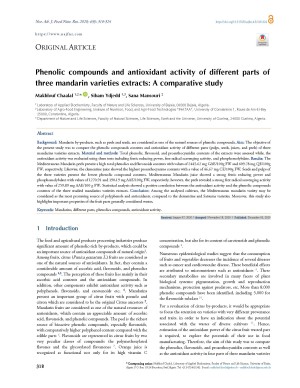Phenolic compounds and antioxidant activity of different parts of three mandarin varieties extracts: A comparative study
Abstract
Background: Mandarin by-products, such as peels and seeds, are considered as one of the naturel source of phenolic compounds. Aim: The objective of the present study was to compare the phenolic compounds contents and antioxidant activity of different parts (pulps, seeds, juices, and peels) of three mandarins varieties extracts. Material and methods: Total phenolic, flavonoid, and proanthocyanidin contents of the extracts were assessed while, the antioxidant activity was evaluated using three tests including ferric reducing power, free radical scavenging activity, and phosphomolybdate. Results: The Mediterranean Mandarin peels present a high total phenolics and flavonoids contents with values of 2445.62 mg GAE/100g FW and 609.78 mg QE/100g FW, respectively. Likewise, the clementine juice showed the highest proanthocyanins contents with value of 46.67 mg CE/100g FW. Seeds and pulps of the three varieties present the lowest phenolic compound contents. Mediterranean Mandarin juice showed a strong ferric reducing power and phosphomolybdate with values of 1270.91 and 190.19 mg AAE/100g FW, respectively, however, the peels reveled a strong free radical scavenging activity with value of 259.89 mg AAE/100 g FW. Statistical analysis showed a positive correlation between the antioxidant activity and the phenolic compounds contents of the three studied mandarins varieties extracts. Conclusion: Among the analyzed cultivars, Mediterranean mandarin variety may be considered as the most promising source of polyphenols and antioxidants, compared to the clementine and Satsuma varieties. Moreover, this study also highlights important properties of the fruit parts generally considered wastes.
Full text article
Authors
Copyright (c) 2020 Authors

This work is licensed under a Creative Commons Attribution 4.0 International License.
-
Attribution — You must give appropriate credit, provide a link to the license, and indicate if changes were made. You may do so in any reasonable manner, but not in any way that suggests the licensor endorses you or your use.
-
No additional restrictions — You may not apply legal terms or technological measures that legally restrict others from doing anything the license permits.





